check engine light Alfa Romeo 147 2010 Owner handbook (in English)
[x] Cancel search | Manufacturer: ALFA ROMEO, Model Year: 2010, Model line: 147, Model: Alfa Romeo 147 2010Pages: 291, PDF Size: 5.52 MB
Page 183 of 291
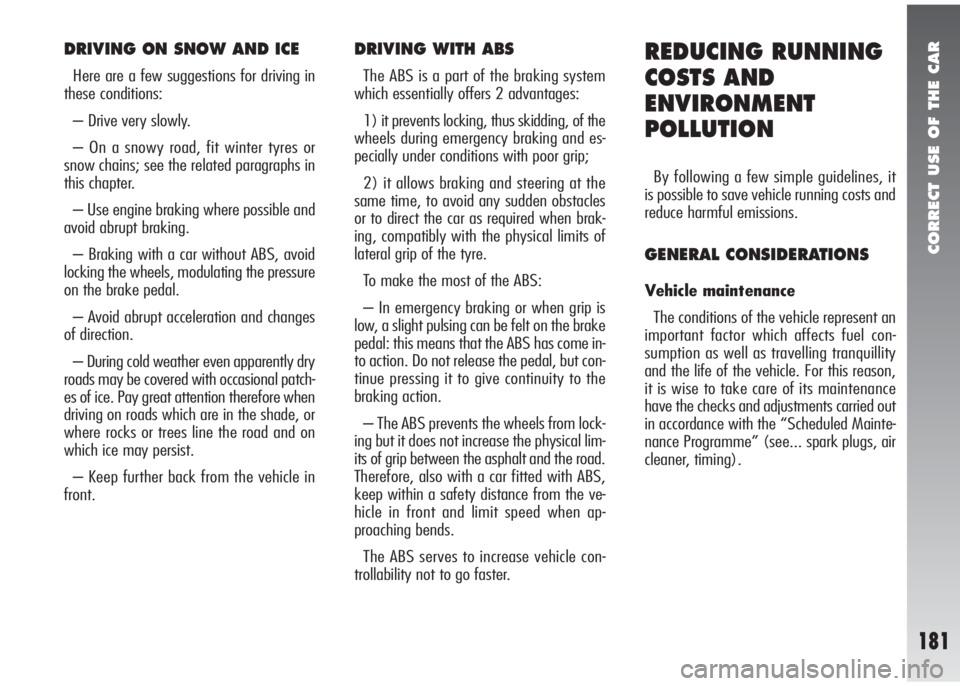
CORRECT USE OF THE CAR
181
DRIVING ON SNOW AND ICE
Here are a few suggestions for driving in
these conditions:
– Drive very slowly.
– On a snowy road, fit winter tyres or
snow chains; see the related paragraphs in
this chapter.
– Use engine braking where possible and
avoid abrupt braking.
– Braking with a car without ABS, avoid
locking the wheels, modulating the pressure
on the brake pedal.
– Avoid abrupt acceleration and changes
of direction.
– During cold weather even apparently dry
roads may be covered with occasional patch-
es of ice. Pay great attention therefore when
driving on roads which are in the shade, or
where rocks or trees line the road and on
which ice may persist.
– Keep further back from the vehicle in
front.
DRIVING WITH ABS
The ABS is a part of the braking system
which essentially offers 2 advantages:
1) it prevents locking, thus skidding, of the
wheels during emergency braking and es-
pecially under conditions with poor grip;
2) it allows braking and steering at the
same time, to avoid any sudden obstacles
or to direct the car as required when brak-
ing, compatibly with the physical limits of
lateral grip of the tyre.
To make the most of the ABS:
– In emergency braking or when grip is
low, a slight pulsing can be felt on the brake
pedal: this means that the ABS has come in-
to action. Do not release the pedal, but con-
tinue pressing it to give continuity to the
braking action.
– The ABS prevents the wheels from lock-
ing but it does not increase the physical lim-
its of grip between the asphalt and the road.
Therefore, also with a car fitted with ABS,
keep within a safety distance from the ve-
hicle in front and limit speed when ap-
proaching bends.
The ABS serves to increase vehicle con-
trollability not to go faster.
REDUCING RUNNING
COSTS AND
ENVIRONMENT
POLLUTION
By following a few simple guidelines, it
is possible to save vehicle running costs and
reduce harmful emissions.
GENERAL CONSIDERATIONS
Vehicle maintenance
The conditions of the vehicle represent an
important factor which affects fuel con-
sumption as well as travelling tranquillity
and the life of the vehicle. For this reason,
it is wise to take care of its maintenance
have the checks and adjustments carried out
in accordance with the “Scheduled Mainte-
nance Programme” (see... spark plugs, air
cleaner, timing).
Page 184 of 291
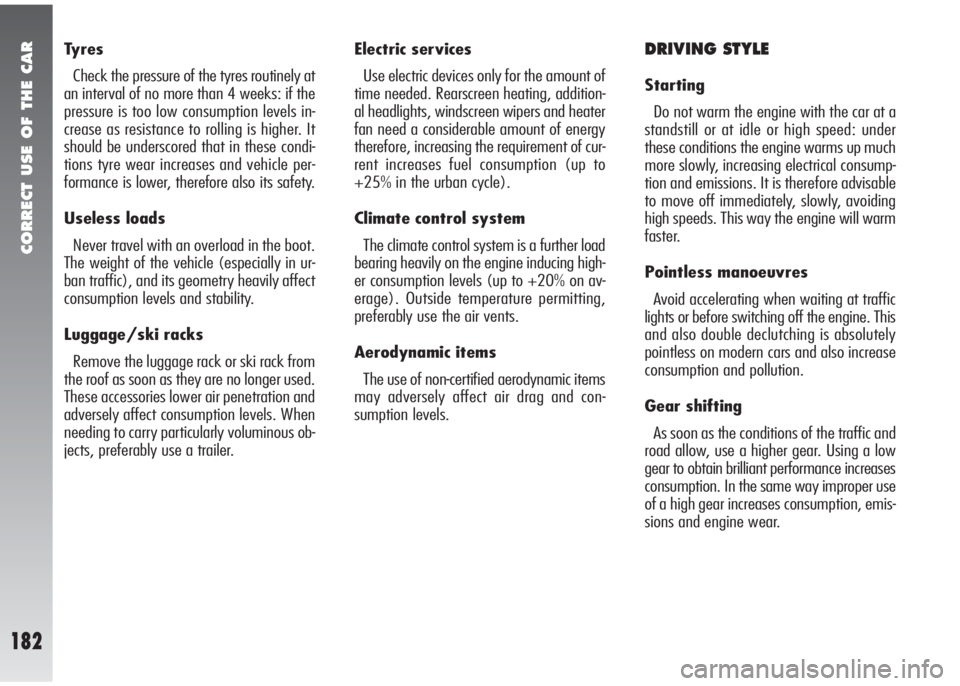
CORRECT USE OF THE CAR
182
Tyres
Check the pressure of the tyres routinely at
an interval of no more than 4 weeks: if the
pressure is too low consumption levels in-
crease as resistance to rolling is higher. It
should be underscored that in these condi-
tions tyre wear increases and vehicle per-
formance is lower, therefore also its safety.
Useless loads
Never travel with an overload in the boot.
The weight of the vehicle (especially in ur-
ban traffic), and its geometry heavily affect
consumption levels and stability.
Luggage/ski racks
Remove the luggage rack or ski rack from
the roof as soon as they are no longer used.
These accessories lower air penetration and
adversely affect consumption levels. When
needing to carry particularly voluminous ob-
jects, preferably use a trailer.Electric services
Use electric devices only for the amount of
time needed. Rearscreen heating, addition-
al headlights, windscreen wipers and heater
fan need a considerable amount of energy
therefore, increasing the requirement of cur-
rent increases fuel consumption (up to
+25% in the urban cycle).
Climate control system
The climate control system is a further load
bearing heavily on the engine inducing high-
er consumption levels (up to +20% on av-
erage). Outside temperature permitting,
preferably use the air vents.
Aerodynamic items
The use of non-certified aerodynamic items
may adversely affect air drag and con-
sumption levels.DRIVING STYLE
Starting
Do not warm the engine with the car at a
standstill or at idle or high speed: under
these conditions the engine warms up much
more slowly, increasing electrical consump-
tion and emissions. It is therefore advisable
to move off immediately, slowly, avoiding
high speeds. This way the engine will warm
faster.
Pointless manoeuvres
Avoid accelerating when waiting at traffic
lights or before switching off the engine. This
and also double declutching is absolutely
pointless on modern cars and also increase
consumption and pollution.
Gear shifting
As soon as the conditions of the traffic and
road allow, use a higher gear. Using a low
gear to obtain brilliant performance increases
consumption. In the same way improper use
of a high gear increases consumption, emis-
sions and engine wear.
Page 195 of 291
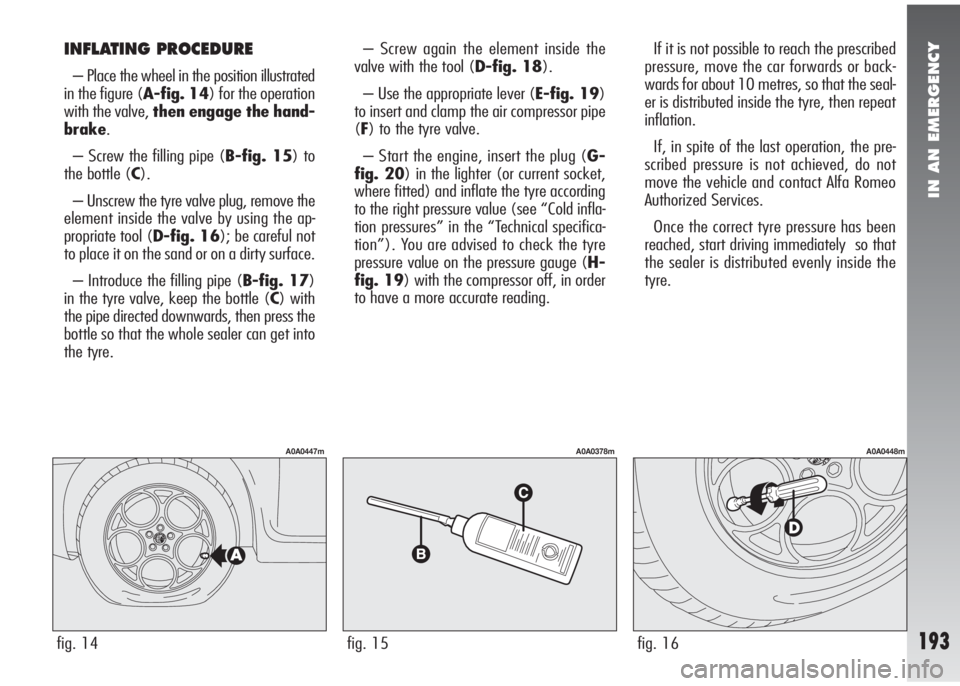
IN AN EMERGENCY
193
INFLATING PROCEDURE
– Place the wheel in the position illustrated
in the figure (A-fig. 14) for the operation
with the valve, then engage the hand-
brake.
– Screw the filling pipe (B-fig. 15) to
the bottle (C).
– Unscrew the tyre valve plug, remove the
element inside the valve by using the ap-
propriate tool (D-fig. 16); be careful not
to place it on the sand or on a dirty surface.
– Introduce the filling pipe (B-fig. 17)
in the tyre valve, keep the bottle (C) with
the pipe directed downwards, then press the
bottle so that the whole sealer can get into
the tyre.– Screw again the element inside the
valve with the tool (D-fig. 18).
– Use the appropriate lever (E-fig. 19)
to insert and clamp the air compressor pipe
(F) to the tyre valve.
– Start the engine, insert the plug (G-
fig. 20) in the lighter (or current socket,
where fitted) and inflate the tyre according
to the right pressure value (see “Cold infla-
tion pressures” in the “Technical specifica-
tion”). You are advised to check the tyre
pressure value on the pressure gauge (H-
fig. 19) with the compressor off, in order
to have a more accurate reading.If it is not possible to reach the prescribed
pressure, move the car forwards or back-
wards for about 10 metres, so that the seal-
er is distributed inside the tyre, then repeat
inflation.
If, in spite of the last operation, the pre-
scribed pressure is not achieved, do not
move the vehicle and contact Alfa Romeo
Authorized Services.
Once the correct tyre pressure has been
reached, start driving immediately so that
the sealer is distributed evenly inside the
tyre.
fig. 14
A0A0447m
fig. 15
A0A0378m
fig. 16
A0A0448m
Page 201 of 291

IN AN EMERGENCY
199
Front fog lights(fig. 23a)
IMPORTANT When needing to change
the left bulb, the side trim next to the light
itself needs to be removed to facilitate ac-
cess to the engine compartment.
To change the bulb, proceed as follows:
– Remove the protective cover turning it
counter-clockwise.
– Disconnect the electric connector (A).
– Release the bulb catch (B).
– Remove the bulb and replace it.
– Fit a new bulb, making the tab of the
metal part coincide with the one on the
lamp unit, then hook the bulb holder catch
(B).
– Reconnect the electric connector (A).
– Refit the protective cover correctly.Xenon dipped beam
headlights
(fig. 23b)
To change the bulb, proceed as follows:
– Remove the protective cover releasing
the locking screws.
– Disconnect the electric connector (A)
turning it slightly counter-clockwise.
– Remove ring nut (B) turning it slightly
counter-clockwise
– Remove the bulb and replace it.
– Fit a new bulb correctly observing the
grooves on the lamp lens, then refit the ring
nut (B).
– Reconnect the electric connector (A).
– Refit the protective cover correctly.
Front sidelights(fig. 24a)
To change the bulb, proceed as follows:
– Remove the protective cover releasing
the locking screws.
– Using the extension (A), integral with
the bulb holder (B), withdraw the bulb hold-
er itself which is snap-fitted.
– Remove the bulb (C), pushing it gen-
tly and turning it counter-clockwise.
– Change the bulb and refit the bulb hold-
er making sure that it clicks into place; al-
so check that the bulb is in the correct po-
sition looking at the lamp from outside.
– Refit the protective cover correctly.
fig. 23a
A0A0499m
fig. 23b
A0A0500m
fig. 24a
A0A0501m
Page 203 of 291
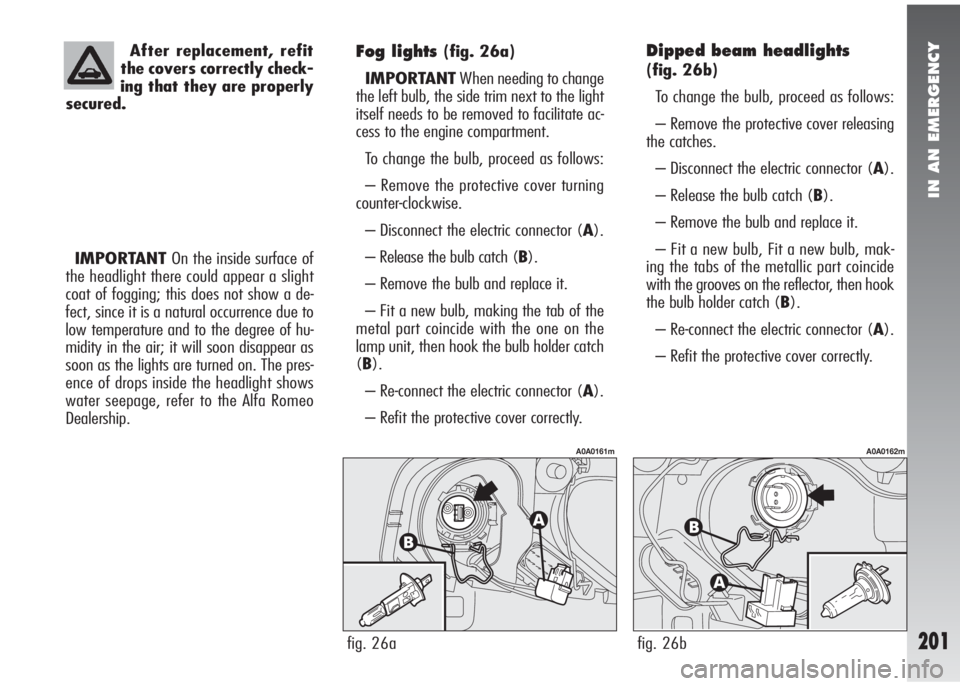
IN AN EMERGENCY
201
After replacement, refit
the covers correctly check-
ing that they are properly
secured.
IMPORTANTOn the inside surface of
the headlight there could appear a slight
coat of fogging; this does not show a de-
fect, since it is a natural occurrence due to
low temperature and to the degree of hu-
midity in the air; it will soon disappear as
soon as the lights are turned on. The pres-
ence of drops inside the headlight shows
water seepage, refer to the Alfa Romeo
Dealership.
Fog lights(fig. 26a)
IMPORTANTWhen needing to change
the left bulb, the side trim next to the light
itself needs to be removed to facilitate ac-
cess to the engine compartment.
To change the bulb, proceed as follows:
– Remove the protective cover turning
counter-clockwise.
– Disconnect the electric connector (A).
– Release the bulb catch (B).
– Remove the bulb and replace it.
– Fit a new bulb, making the tab of the
metal part coincide with the one on the
lamp unit, then hook the bulb holder catch
(B).
– Re-connect the electric connector (A).
– Refit the protective cover correctly.Dipped beam headlights
(fig. 26b)
To change the bulb, proceed as follows:
– Remove the protective cover releasing
the catches.
– Disconnect the electric connector (A).
– Release the bulb catch (B).
– Remove the bulb and replace it.
– Fit a new bulb, Fit a new bulb, mak-
ing the tabs of the metallic part coincide
with the grooves on the reflector, then hook
the bulb holder catch (B).
– Re-connect the electric connector (A).
– Refit the protective cover correctly.
fig. 26a
A0A0161m
fig. 26b
A0A0162m
Page 224 of 291
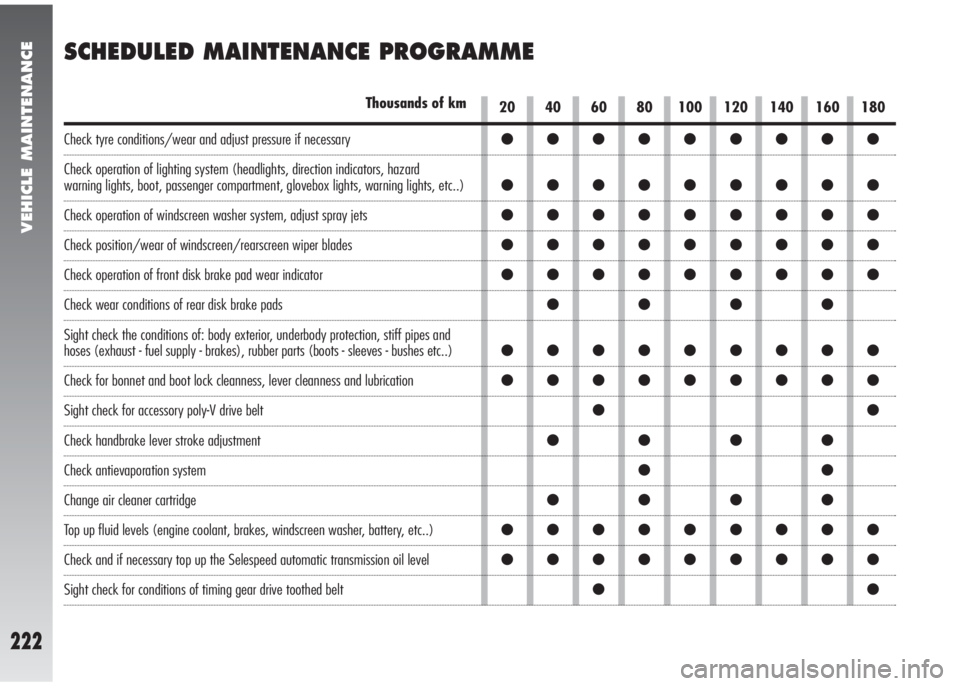
●●●●●●●●●
●●●●●●●●●
●●●●●●●●●
●●●●●●●●●
●●●●●●●●●
●●●●
●●●●●●●●●
●●●●●●●●●
●●
●●●●
●●
●●●●
●●●●●●●●●
●●●●●●●●●
●●
VEHICLE MAINTENANCE
222
SCHEDULED MAINTENANCE PROGRAMME
20 40 60 80 100 120 140 160 180Thousands of km
Check tyre conditions/wear and adjust pressure if necessary
Check operation of lighting system (headlights, direction indicators, hazard
warning lights, boot, passenger compartment, glovebox lights, warning lights, etc..)
Check operation of windscreen washer system, adjust spray jets
Check position/wear of windscreen/rearscreen wiper blades
Check operation of front disk brake pad wear indicator
Check wear conditions of rear disk brake pads
Sight check the conditions of: body exterior, underbody protection, stiff pipes and
hoses (exhaust - fuel supply - brakes), rubber parts (boots - sleeves - bushes etc..)
Check for bonnet and boot lock cleanness, lever cleanness and lubrication
Sight check for accessory poly-V drive belt
Check handbrake lever stroke adjustment
Check antievaporation system
Change air cleaner cartridge
Top up fluid levels (engine coolant, brakes, windscreen washer, battery, etc..)
Check and if necessary top up the Selespeed automatic transmission oil level
Sight check for conditions of timing gear drive toothed belt
Page 226 of 291
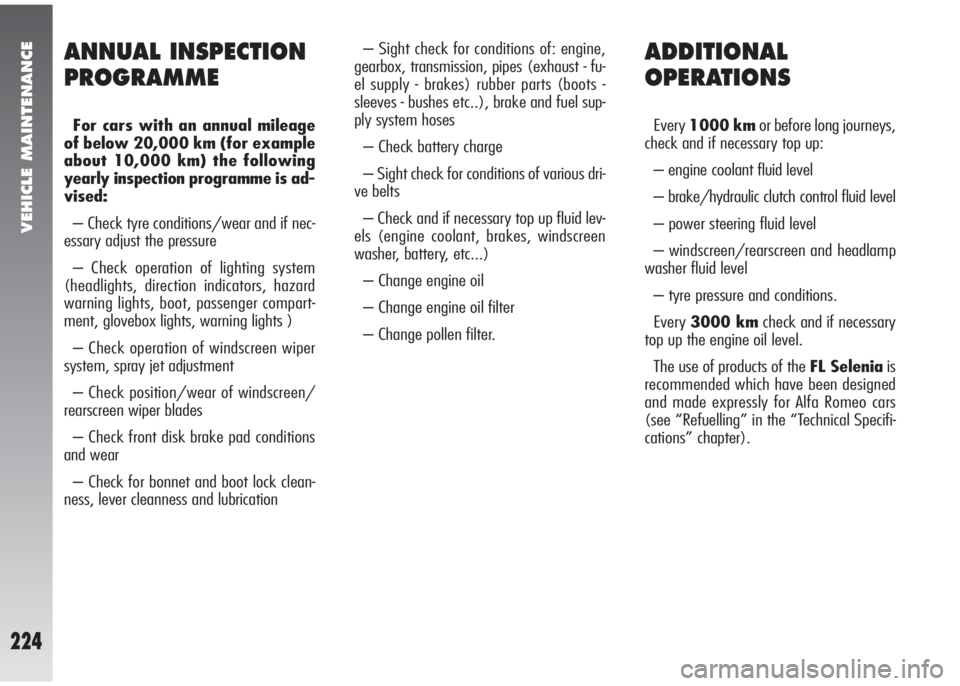
VEHICLE MAINTENANCE
224
ADDITIONAL
OPERATIONS
Every 1000 kmor before long journeys,
check and if necessary top up:
– engine coolant fluid level
– brake/hydraulic clutch control fluid level
– power steering fluid level
– windscreen/rearscreen and headlamp
washer fluid level
– tyre pressure and conditions.
Every 3000 kmcheck and if necessary
top up the engine oil level.
The use of products of the FL Seleniais
recommended which have been designed
and made expressly for Alfa Romeo cars
(see “Refuelling” in the “Technical Specifi-
cations” chapter).
ANNUAL INSPECTION
PROGRAMME
For cars with an annual mileage
of below 20,000 km (for example
about 10,000 km) the following
yearly inspection programme is ad-
vised:
– Check tyre conditions/wear and if nec-
essary adjust the pressure
– Check operation of lighting system
(headlights, direction indicators, hazard
warning lights, boot, passenger compart-
ment, glovebox lights, warning lights )
– Check operation of windscreen wiper
system, spray jet adjustment
– Check position/wear of windscreen/
rearscreen wiper blades
– Check front disk brake pad conditions
and wear
– Check for bonnet and boot lock clean-
ness, lever cleanness and lubrication– Sight check for conditions of: engine,
gearbox, transmission, pipes (exhaust - fu-
el supply - brakes) rubber parts (boots -
sleeves - bushes etc..), brake and fuel sup-
ply system hoses
– Check battery charge
– Sight check for conditions of various dri-
ve belts
– Check and if necessary top up fluid lev-
els (engine coolant, brakes, windscreen
washer, battery, etc...)
– Change engine oil
– Change engine oil filter
– Change pollen filter.
Page 233 of 291
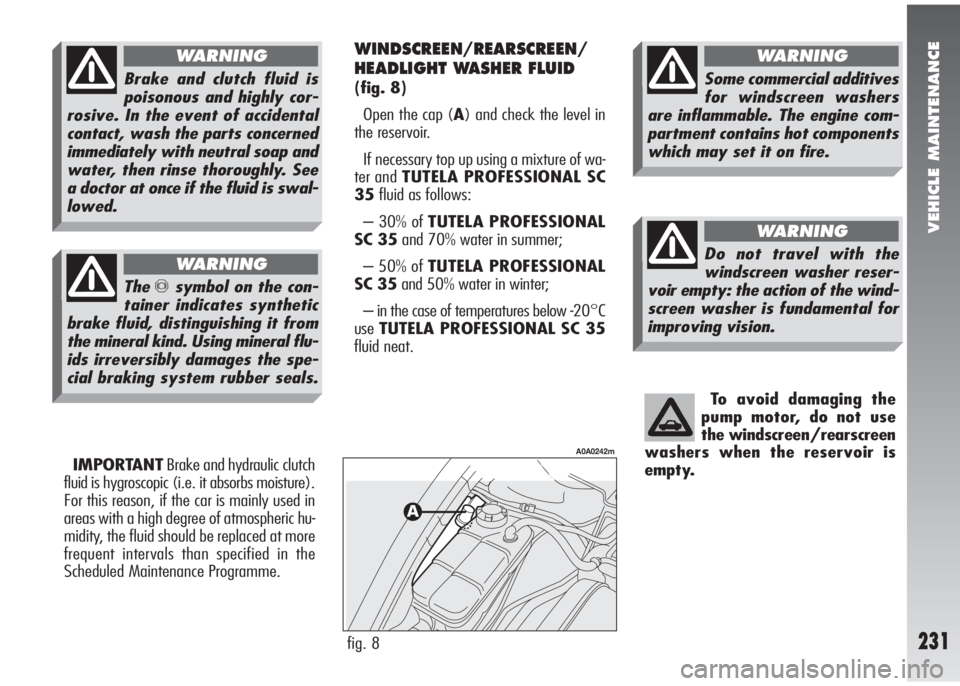
VEHICLE MAINTENANCE
231
To avoid damaging the
pump motor, do not use
the windscreen/rearscreen
washers when the reservoir is
empty.
IMPORTANTBrake and hydraulic clutch
fluid is hygroscopic (i.e. it absorbs moisture).
For this reason, if the car is mainly used in
areas with a high degree of atmospheric hu-
midity, the fluid should be replaced at more
frequent intervals than specified in the
Scheduled Maintenance Programme.
WINDSCREEN/REARSCREEN/
HEADLIGHT WASHER FLUID
(fig. 8)
Open the cap (A) and check the level in
the reservoir.
If necessary top up using a mixture of wa-
ter and TUTELA PROFESSIONAL SC
35fluid as follows:
– 30% of TUTELA PROFESSIONAL
SC 35and 70% water in summer;
– 50% of TUTELA PROFESSIONAL
SC 35and 50% water in winter;
– in the case of temperatures below -20°C
useTUTELA PROFESSIONAL SC 35
fluid neat.
fig. 8
A0A0242m
Theπsymbol on the con-
tainer indicates synthetic
brake fluid, distinguishing it from
the mineral kind. Using mineral flu-
ids irreversibly damages the spe-
cial braking system rubber seals.
WARNING
Brake and clutch fluid is
poisonous and highly cor-
rosive. In the event of accidental
contact, wash the parts concerned
immediately with neutral soap and
water, then rinse thoroughly. See
a doctor at once if the fluid is swal-
lowed.
WARNING
Do not travel with the
windscreen washer reser-
voir empty: the action of the wind-
screen washer is fundamental for
improving vision.
WARNING
Some commercial additives
for windscreen washers
are inflammable. The engine com-
partment contains hot components
which may set it on fire.
WARNING
Page 237 of 291
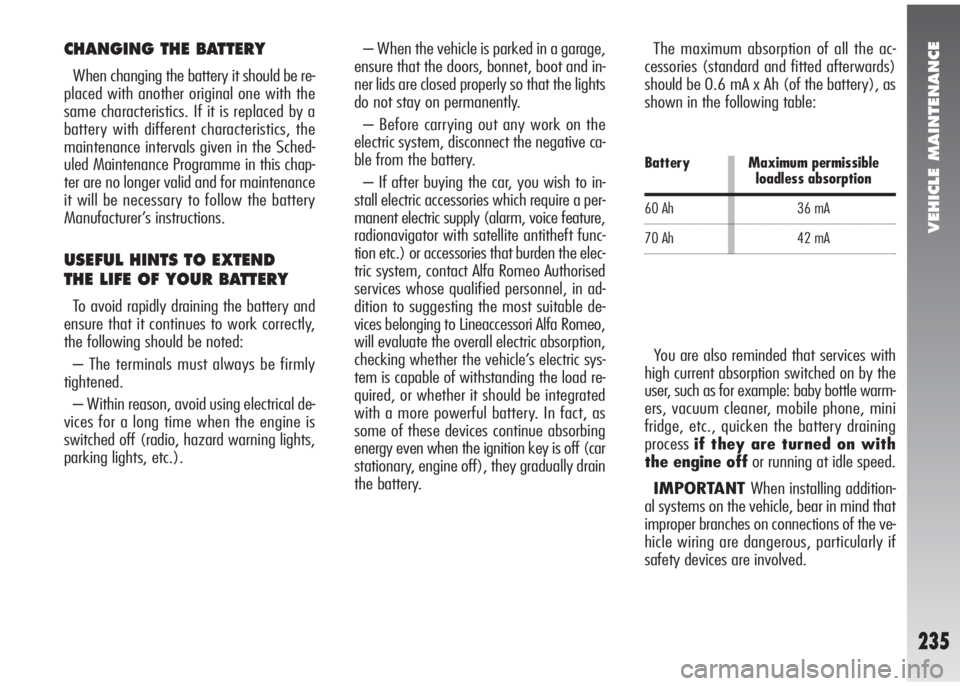
VEHICLE MAINTENANCE
235
You are also reminded that services with
high current absorption switched on by the
user, such as for example: baby bottle warm-
ers, vacuum cleaner, mobile phone, mini
fridge, etc., quicken the battery draining
processif they are turned on with
the engine offor running at idle speed.
IMPORTANT When installing addition-
al systems on the vehicle, bear in mind that
improper branches on connections of the ve-
hicle wiring are dangerous, particularly if
safety devices are involved.
Battery
60 Ah
70 AhMaximum permissible
loadless absorption
36 mA
42 mA
The maximum absorption of all the ac-
cessories (standard and fitted afterwards)
should be 0.6 mA x Ah (of the battery), as
shown in the following table:CHANGING THE BATTERY
When changing the battery it should be re-
placed with another original one with the
same characteristics. If it is replaced by a
battery with different characteristics, the
maintenance intervals given in the Sched-
uled Maintenance Programme in this chap-
ter are no longer valid and for maintenance
it will be necessary to follow the battery
Manufacturer’s instructions.
USEFUL HINTS TO EXTEND
THE LIFE OF YOUR BATTERY
To avoid rapidly draining the battery and
ensure that it continues to work correctly,
the following should be noted:
– The terminals must always be firmly
tightened.
– Within reason, avoid using electrical de-
vices for a long time when the engine is
switched off (radio, hazard warning lights,
parking lights, etc.).– When the vehicle is parked in a garage,
ensure that the doors, bonnet, boot and in-
ner lids are closed properly so that the lights
do not stay on permanently.
– Before carrying out any work on the
electric system, disconnect the negative ca-
ble from the battery.
– If after buying the car, you wish to in-
stall electric accessories which require a per-
manent electric supply (alarm, voice feature,
radionavigator with satellite antitheft func-
tion etc.) or accessories that burden the elec-
tric system, contact Alfa Romeo Authorised
services whose qualified personnel, in ad-
dition to suggesting the most suitable de-
vices belonging to Lineaccessori Alfa Romeo,
will evaluate the overall electric absorption,
checking whether the vehicle’s electric sys-
tem is capable of withstanding the load re-
quired, or whether it should be integrated
with a more powerful battery. In fact, as
some of these devices continue absorbing
energy even when the ignition key is off (car
stationary, engine off), they gradually drain
the battery.
Page 242 of 291

VEHICLE MAINTENANCE
240
HEADLIGHT WASHERS
Regularly check that the spray jets are in-
tact and clean (fig. 17).
If it is necessary to direct the jet, contact
an Alfa Romeo Authorised Service.
BODYWORK
PROTECTION FROM
ATMOSPHERIC AGENTS
The main causes of corrosion are:
– atmospheric pollution
– salty air and humidity (coastal areas, or
hot humid climates)
– seasonal environment conditions.
Not to be underestimated is also the abra-
sive action of wind-borne atmospheric dust
and sand and mud and gravel raised by oth-
er vehicles.
On your
Alfa 147 GTA, Alfa Romeo
has implemented the best manufacturing
technologies to effectively protect the body-
work against corrosion.
These include:
– Painting products and systems which
give the vehicle particular resistance to cor-
rosion and abrasion.
– Use of galvanised (or pretreated) steel
sheets, with high resistance to corrosion.
– Spraying the underbody, engine com-
partment, wheel arches and other parts with
highly protective wax products.
fig. 17
A0A0425m
– Spraying of plastic parts, with a protec-
tive function, in the more exposed points:
underdoor, inner wheel arch linings, etc.
– Use of “open” boxed sections to pre-
vent condensation and pockets of moisture
from triggering rust inside.
VEHICLE EXTERIOR AND
UNDERBODY WARRANTY
TheAlfa 147 GTAis guaranteed
against perf oration due to rust of any orig-
inal element of the structure or body. For the
general terms of this warranty, refer to the
Warranty Booklet.